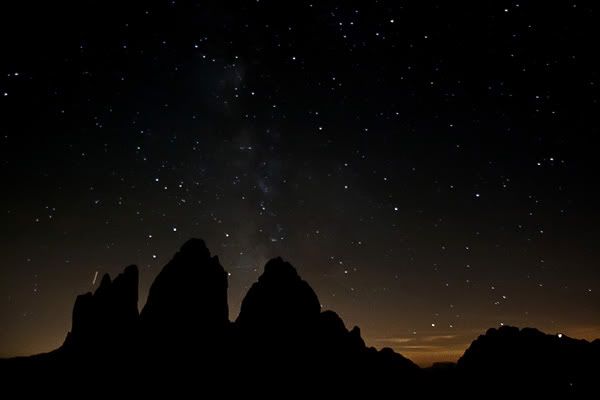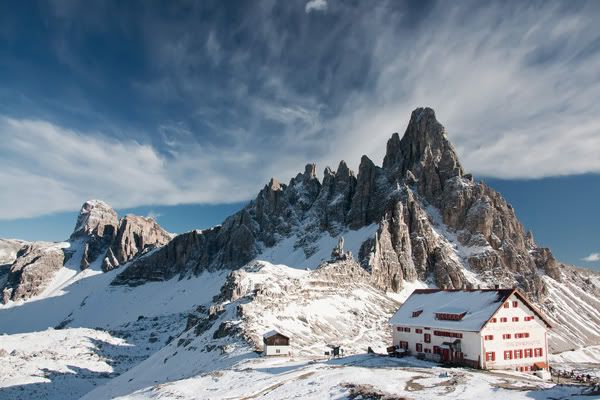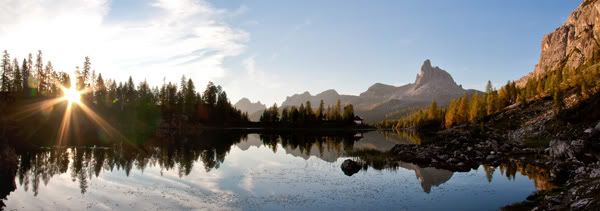pudgy_groundhog
Active member
The trip report in a nutshell:
Two adults, one 3.75 year old, one backpack, two weeks in Italy.
Seven rifugios, twelve nights in the mountains, and a whole lot of jaw dropping scenery.
One amazing trip!
The Dolomites 2011
The longer version (copied from our website):
Steve, Norah, and I traveled to Italy in September 2011 for an amazing stay in the Dolomites. Steve and I had visited the Italian Alps during our Tour Mont Blanc trip eight years ago, but this was our first time to the Dolomites. We hiked through three national and regional parks (Parco Naturale Dolomiti di Sesto, Parco Naturale Fanes Sennes e Braies, and Parco Regionale delle Dolomiti d'Ampezzo) and stayed at seven different rifugios. The scenery was jaw dropping gorgeous, the weather beautiful, the food delicious, and the people friendly - suffice to say, we had a fantastic time!
Similar to our trip in the Alps we utilized a system of mountain huts, called "rifugios" in Italian. The rifugios ranged in amenities and style (depending on their location and how accessible they were), but all offered lodging, hot meals, and showers. As we're used to backpacking and camping - this felt rather luxurious to us! The only requirement of the rifugios is you have to provide your own travel sheet. The rifugios make it possible to sleep in the mountains and string together a longer trek without having to carry that much weight. However, since Norah could not hike entirely on her own and I carried her part of the time, that meant we could only take one backpack for three of us (yes, you read the right - three people, two weeks in Italy, and only one backpack!). We weighed everything before we went (and I mean everything!), had a spreadsheet with all our gear listed, and a lot of negotiations about what to take/leave. Our final pack weight was around 50 lbs - Steve was a trooper to schelp that pack around Italy for two weeks!
On average the rifugios cost 50 euro per person (Norah was free) and this included lodging, dinner, and breakfast (we often purchased lunch as well). Lodging was either in a private room with a shared bathroom or a dormitory room with multiple bunk beds (we only had one night like this). Some nights we had half-board (a more reasonable price) and there was only one dinner option. And other nights we had a choice of three dinners or it was À la carte off the menu. Breakfast was pretty standard everywhere - rolls, butter/jam/nutella, granola, yogurt, cheese, cold cuts, and hot drinks usually served buffet style.
The Dolomites were actually part of the Austro-Hungarian empire before WWI and still show this influence in the food and language. We found many things - towns, mountains, rifugios - were listed with both Italian and German names. Most, if not all, of the people working in the rifugios spoke both Italian and German. This makes the Dolomites very popular with German hikers and indeed, the majority of other hikers we encountered were German. In addition to Italian dishes, there was a lot of goulash (usually served with polenta), Knödel (savory bread dumplings with speck), apple strudel, and Kaiserschmarrn (a shredded pancake dish). We also got to sample some different gnocchi and ravioli dishes that are specialties of the region. Yum!
We flew into Milan and spent our first night in Venice. Next we traveled to San Candido to spend time around Tre Cime de Lavaredo (one of the premier areas of the Dolomites, often referred to as Italy's Matterhorn). From there we would use a trail to hook up with the Alta Via 1 route - one of the most popular long distance routes in the Dolomites. Part way through our trip we realized most of the huts had closed early for the season so we had to rearrange our itinerary, although through day hikes we were able to see most of the area we were going to cover anyway. We finished our hike in Cortina and spent a night there before returning to Milan. For help in planning our trip and for information while hiking we relied heavily upon these books from the Cicerone Press (and would definitely recommend them if you are looking to hike in the Dolomites): Trekking in the Dolomites and Walking in the Dolomites by Gillian Price.
We had an unseasonal snow storm that delayed our hiking by a day, but once we got going we hiked for ten days staying at the rifugios Tre Scarperi, Locatelli, Vallandro, Biella, Fanes, Lagazuoi, and Croda da Lago. Every day was terrific, although our favorites were probably our time around Locatelli, hiking from Fanes to Lagazuoi, and a dayhike from Lagazuoi to Novulau. Not only was the scenery stunning, we hiked through areas that had historical significance as they were sites that saw a lot of action during WWI. We saw many remnants from the war including tunnels, forts, ruins, trenches, caves, and other artifacts like barb wire and tin cans. Another remnant of the war are some of the via ferrata routes. Via Ferrata translates as "road of iron" and it's a mountain route comprised of metal rungs, ladders, and fixed cables. Climbers still use technical gear to clip in, but it's not traditional rock climbing. The first via ferratas were established during WWI to help move troops and equipment through the mountains and many remain today for climbers to use. Steve had the opportunity to do a via ferrata on Mt. Paterno (accessed through a WWI tunnel).
All in all, we loved our time in the Dolomites. Each day we marveled at the dramatic mountains and stunning panoramas - we hope our pictures can convey some of this beauty and that you enjoy browsing the galleries!
--------------------------------------------------------------------
A sampling of some of my favorite pictures:
Steve and Tofana di Rozes, near Rifugio Lagazuoi

Steve and Averau, taken from Rifugio Nuvolau

Steve and Norah with Mt. Paterno, Rifugio Locatelli and Tre Cime

Starry night sky over Tre Cime

Steve and Norah with Torre di Toblin

Rifugio Locatelli and Mt Paterno (day after a snow storm)

Same view at sunrise

Sunrise at Lago Federa (Rifugio Croda da Lago)

Panorama with Rifugio Lagazuoi

Panorama from Picco di Vallandro

Panorama from Rifugio Nuvolau

And a family shot

Thanks for looking! Happy to answer any questions if anybody is thinking about a trip there (obviously, highly recommended!).
Two adults, one 3.75 year old, one backpack, two weeks in Italy.
Seven rifugios, twelve nights in the mountains, and a whole lot of jaw dropping scenery.
One amazing trip!
The Dolomites 2011
The longer version (copied from our website):
Steve, Norah, and I traveled to Italy in September 2011 for an amazing stay in the Dolomites. Steve and I had visited the Italian Alps during our Tour Mont Blanc trip eight years ago, but this was our first time to the Dolomites. We hiked through three national and regional parks (Parco Naturale Dolomiti di Sesto, Parco Naturale Fanes Sennes e Braies, and Parco Regionale delle Dolomiti d'Ampezzo) and stayed at seven different rifugios. The scenery was jaw dropping gorgeous, the weather beautiful, the food delicious, and the people friendly - suffice to say, we had a fantastic time!
Similar to our trip in the Alps we utilized a system of mountain huts, called "rifugios" in Italian. The rifugios ranged in amenities and style (depending on their location and how accessible they were), but all offered lodging, hot meals, and showers. As we're used to backpacking and camping - this felt rather luxurious to us! The only requirement of the rifugios is you have to provide your own travel sheet. The rifugios make it possible to sleep in the mountains and string together a longer trek without having to carry that much weight. However, since Norah could not hike entirely on her own and I carried her part of the time, that meant we could only take one backpack for three of us (yes, you read the right - three people, two weeks in Italy, and only one backpack!). We weighed everything before we went (and I mean everything!), had a spreadsheet with all our gear listed, and a lot of negotiations about what to take/leave. Our final pack weight was around 50 lbs - Steve was a trooper to schelp that pack around Italy for two weeks!
On average the rifugios cost 50 euro per person (Norah was free) and this included lodging, dinner, and breakfast (we often purchased lunch as well). Lodging was either in a private room with a shared bathroom or a dormitory room with multiple bunk beds (we only had one night like this). Some nights we had half-board (a more reasonable price) and there was only one dinner option. And other nights we had a choice of three dinners or it was À la carte off the menu. Breakfast was pretty standard everywhere - rolls, butter/jam/nutella, granola, yogurt, cheese, cold cuts, and hot drinks usually served buffet style.
The Dolomites were actually part of the Austro-Hungarian empire before WWI and still show this influence in the food and language. We found many things - towns, mountains, rifugios - were listed with both Italian and German names. Most, if not all, of the people working in the rifugios spoke both Italian and German. This makes the Dolomites very popular with German hikers and indeed, the majority of other hikers we encountered were German. In addition to Italian dishes, there was a lot of goulash (usually served with polenta), Knödel (savory bread dumplings with speck), apple strudel, and Kaiserschmarrn (a shredded pancake dish). We also got to sample some different gnocchi and ravioli dishes that are specialties of the region. Yum!
We flew into Milan and spent our first night in Venice. Next we traveled to San Candido to spend time around Tre Cime de Lavaredo (one of the premier areas of the Dolomites, often referred to as Italy's Matterhorn). From there we would use a trail to hook up with the Alta Via 1 route - one of the most popular long distance routes in the Dolomites. Part way through our trip we realized most of the huts had closed early for the season so we had to rearrange our itinerary, although through day hikes we were able to see most of the area we were going to cover anyway. We finished our hike in Cortina and spent a night there before returning to Milan. For help in planning our trip and for information while hiking we relied heavily upon these books from the Cicerone Press (and would definitely recommend them if you are looking to hike in the Dolomites): Trekking in the Dolomites and Walking in the Dolomites by Gillian Price.
We had an unseasonal snow storm that delayed our hiking by a day, but once we got going we hiked for ten days staying at the rifugios Tre Scarperi, Locatelli, Vallandro, Biella, Fanes, Lagazuoi, and Croda da Lago. Every day was terrific, although our favorites were probably our time around Locatelli, hiking from Fanes to Lagazuoi, and a dayhike from Lagazuoi to Novulau. Not only was the scenery stunning, we hiked through areas that had historical significance as they were sites that saw a lot of action during WWI. We saw many remnants from the war including tunnels, forts, ruins, trenches, caves, and other artifacts like barb wire and tin cans. Another remnant of the war are some of the via ferrata routes. Via Ferrata translates as "road of iron" and it's a mountain route comprised of metal rungs, ladders, and fixed cables. Climbers still use technical gear to clip in, but it's not traditional rock climbing. The first via ferratas were established during WWI to help move troops and equipment through the mountains and many remain today for climbers to use. Steve had the opportunity to do a via ferrata on Mt. Paterno (accessed through a WWI tunnel).
All in all, we loved our time in the Dolomites. Each day we marveled at the dramatic mountains and stunning panoramas - we hope our pictures can convey some of this beauty and that you enjoy browsing the galleries!
--------------------------------------------------------------------
A sampling of some of my favorite pictures:
Steve and Tofana di Rozes, near Rifugio Lagazuoi

Steve and Averau, taken from Rifugio Nuvolau

Steve and Norah with Mt. Paterno, Rifugio Locatelli and Tre Cime

Starry night sky over Tre Cime

Steve and Norah with Torre di Toblin

Rifugio Locatelli and Mt Paterno (day after a snow storm)

Same view at sunrise

Sunrise at Lago Federa (Rifugio Croda da Lago)

Panorama with Rifugio Lagazuoi

Panorama from Picco di Vallandro

Panorama from Rifugio Nuvolau

And a family shot

Thanks for looking! Happy to answer any questions if anybody is thinking about a trip there (obviously, highly recommended!).

